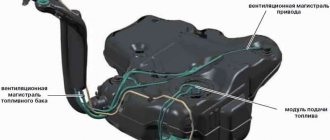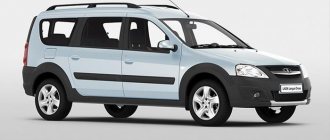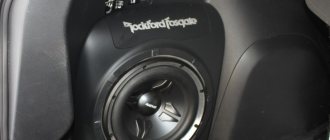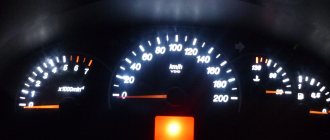In April 2012, AVTOVAZ began production of a new Russian-made station wagon, Lada Largus (Lada Lapryc), which is a 2006 Dacia Logan MCV adapted for the Russian market, produced in Romania.
The car was created on the B0 platform, which served as the basis for the Logan and Sandero cars. In addition to station wagons, the plant also produces vans.
Test tests have shown that the car is well prepared for Russian operating conditions. The station wagon is available in five- and seven-seat versions. Moreover, the third row of seats can comfortably accommodate adult passengers. Thanks to folding seats, the car interior can be easily transformed to suit any needs - from a tourist trip to the transportation of large cargo. The third row of seats can be removed from the cabin, this allows you to significantly increase the volume of the luggage compartment. In the seven-seater version it is modest - only 135 liters. But the five-seater version already has 560 liters of volume. The front suspension is independent, MacPherson type with wishbones and anti-roll bar. The rear suspension is dependent with a U-shaped beam and trailing arms connecting the beam to the body.
The large wheelbase provides the car with good handling and stability on the road. The front brakes are ventilated discs, the rear brakes are drums. In expensive versions, the car is equipped with an anti-lock braking system (ABS).
The cars are equipped with a four-cylinder 8-valve petrol engine with a volume of 1.6 liters and a power of 62 kW (84 hp), or a 16-valve engine with a volume of 1.6 liters and a power of 77 kW (105 hp). Both engines meet Euro 4 emission standards. All cars are equipped with a five-speed manual transmission. Starting from 2020, engines manufactured by AvtoVAZ are installed (more details).
The car is available in three trim levels: “Norma”, “Standard” and “Lux”.
Options include a height-adjustable steering column, air conditioning, power steering (power steering), front and rear power windows, electrically adjustable and heated outside rear-view mirrors, and a CD/MP3 radio.
Technical characteristics of Lada Largus Station wagon (1.6 l 8-cl. (87 hp) and 1.6 l 16-cl. (106 hp))
Technical characteristics of Lada Largus station wagon CNG (gas)
Technical characteristics of Lada Largus Cross
Technical characteristics of Lada Largus Cross CNG (gas)
Technical characteristics of Lada Largus Van
Technical characteristics of Lada Largus Van CNG (gas)
General characteristics depending on the configuration
technical specifications">
| Options | "Universal" 7-seater | "Universal" 5-seater | "Van" | |||
| K4M/21129/ JR5 | 11189/JR5 | K4M/21129/ JR5 | 11189/JR5 | K4M/21129/ JR5 | 11189/JR5 | |
| "Luxe" | "Norma" | "Luxe" | "Standard" "Norma" | "Luxe" | "Standard" "Norma" | |
| Engine capacity | 1.6 l 16V | 1.6 l 8V | 1.6 l 16V | 1.6 l 8V | 1.6 l 16V | 1.6 l 8V |
| Number of doors | 6 | |||||
| Length, mm | 4470 | |||||
| Width, mm | 1750 | |||||
| Height without roof rails (at curb weight), mm | — | 1650 | ||||
| Height with roof rails (at curb weight), mm | 1670 | — | ||||
| Base, mm | 2905 | 2905 | ||||
| Front track, mm | 1469 | 1468 | ||||
| Rear track, mm | 1466 | 1466 | ||||
| Front overhang, mm | 795 | 795 | ||||
| Rear overhang, mm | 770 | 770 | ||||
| Ground clearance at full weight, mm | 145 (minimum ground clearance corresponds to the point under the engine mudguards) | |||||
| Trunk volume (VDA), dm3 | 135 | 560 | 2540 | |||
| Weight of the vehicle in running order, kg**, with driver | 1330… 1370 | 1260… 1345 | 1260…1275 | |||
| Permitted maximum weight (technically permissible), kg | 1810… 1850 | 1705… 1790 | 1985… 2000 | |||
| Maximum weight on the front axle (technically permissible), kg | 930 | 940 | ||||
| Maximum weight on the rear axle (technically permissible), kg | 1080 | 1160 | ||||
| Permissible total weight of a towed trailer, not equipped with brakes, kg | 650 (420 for a car without ABS) | |||||
| Permissible total weight of a towed trailer equipped with brakes, kg | 1300 | 1300 | 1300 | — | ||
| Permitted maximum weight with trailer, kg | 2650 | 2650 | 2650 | 2600 | ||
| 75 | ||||||
| Permissible load on the roof rack (including the weight of the rack), kg | 80 | |||||
| Maximum speed, km/h*** | 165 | 158 | 165 | 158 | 165 | 158 |
| Acceleration 0-100 km/h, s*** | 13,5 | 14,4 | 13,1 | 14,2 | 14,0 | 15,4 |
| Fuel consumption, l/100 km (combined cycle) | 9,0 | 9,5 | 9,0 | 9,3 | 9,0 | 9,3 |
| Wheels | 6.0 J15 | |||||
| Tires | 185/65R15 | |||||
| Turning diameter according to clearance, m | 11,25 | |||||
| Fuel tank volume, l | 50 | |||||
When loading a vehicle to its full weight, the weight of the trailer should not lead to excess weight of the road train. ** The curb weight indicated in this table corresponds to the weight of the empty vehicle. *** Technical characteristics are measured using special methods, serve to compare different cars and are not operational standards!
DISTINCTIVE FEATURES OF THE LADA LARGUS CROSS CAR
The equipment of LADA Largus Cross cars is distinguished by increased ground clearance (by 25 mm), original wheels with a diameter of 16 inches, tires of increased size (205/55R16), original seat upholstery, decorative inserts for door trim and instrument panels, protective linings for the body, front and rear bumpers, black decorative films on the door frames, door sills with Largus Cross embossing, Largus Cross nameplate on the right tailgate. The remaining technical characteristics are similar to the Largus “station wagon”.
Different technical characteristics of the Cross and Station Wagon modifications
5 minutes to read.
The volume of the fuel tank of the Lada Largus, according to the technical documentation, is approximately 50 liters. In fact, this indicator is somewhat more significant.
Lada Largus is a fairly common car in the CIS.
According to the technical specifications, its declared volume is about 50 liters. In fact, you can put a little more fuel into it.
Lada Largus: declared tank volume
Currently, according to technical documentation, approximately 50 liters of fuel can be filled into this car. Considering the fuel consumption of this car model, gasoline will be enough for approximately 450 km of driving within the city and 700 km of driving on a flat highway outside of it.
In fact, the volume of the fuel tank of the Lada Largus car is somewhat larger. Many of their owners managed to fill up not 50, but 65 liters at once, which, naturally, caused complete satisfaction. The fact is that with this amount of fuel the car will be able to travel approximately 600 km within the city and about 900 km on a flat highway. So why is there such a dissonance between the declared and actual volume of the fuel tank of the Lada Largus?
How many liters are in the Kia Seltos tank if the light on the dash comes on?
Alas, everyone is familiar with the situation when the fuel in the tank is rapidly running out, and a light with a gas station icon lights up on the dashboard, thereby informing the driver that it is necessary to visit a gas station.
But not everyone knows when a light bulb goes on. Obviously there is still gas in the tank, but how much? According to my personal observations, the lamp on the dashboard lights up when there is less than 10 liters of fuel left in the tank. This amount of gasoline will be enough to get to the nearest gas station if you are within the city.
You can drive from 50 to 100 km with a burning lamp, but you shouldn’t wait until the last minute, but it’s better to immediately stop at a gas station and fill up with fuel. Firstly, we may simply not get to the gas station. Secondly, the fuel pump is cooled and lubricated by fuel, and if the gasoline level is low, it may simply fail. Thirdly, dirt always accumulates at the bottom of the fuel tank. If there is little gasoline, dirt will rise from the bottom and enter the fuel filter, which will lead to its rapid clogging.
The secret of increased performance
Currently, manufacturers of Lada Largus cars indicate in the technical documentation attached to it the dimensions of their fuel tank, equal to approximately 50 liters. In fact, you can put a lot more gasoline into it. There are several reasons for this:
- relatively large fuel tank neck;
- deliberate application of a slightly smaller volume by manufacturers to comply with technical documentation;
- the presence of special voids in the tank that increase its level of wear resistance;
- errors in the operation of refueling equipment.
About the long neck
Naturally, the creators of the Lada Largus car, if possible, would indicate exactly 65 liters of fuel in the technical parameters, if they had such an opportunity. In fact, almost any car can be filled with slightly more gasoline than is indicated in the documentation. This is due to the fact that not the entire actual volume of the fuel tank is subject to accounting. The fact is that the neck is not an accounting space.
At the same time, in the Lada Largus car it has increased dimensions in comparison with other models. As a result, several liters of fuel will easily fit there.
Better to play it safe
Another important point to understand is the fact that manufacturers indicate not the exact, but the approximate volume of the fuel tank. Moreover, in reality, in no case should it be smaller in size than what is written in the application from the manufacturer. It is for this reason that companies play it safe and indicate a slightly smaller fuel tank volume.
All gas stations lie
We should also not forget that unscrupulous gas stations can “increase” the amount of fuel they can hold without any problems. In fact, there are even officially indicated “miscalculations” of equipment during the process of pouring gasoline into a car. Most often we are talking about 50 ml per 10 liters. What can we say about unofficial “mistakes”.
Safety first
Another reason for such differences should be sought in the physical properties of gasoline itself. The fact is that during the heating process it expands quite strongly. So, if the fuel tank does not have additional volume, it can lead to failure. It is to avoid such excesses that any tank has special hollow protrusions.
Under normal conditions, after firing the refueling nozzle, they are still empty. If you wait a little and try to continue refueling, these reserve spaces will also be filled.
Gas tank capacity in Largus
The remaining technical characteristics are similar to the Largus “station wagon”.
| Options | "Universal" 7-seater | "Universal" 5-seater | "Van" | |||
| K4M/21129/ JR5 | 11189/JR5 | K4M/21129/ JR5 | 11189/JR5 | K4M/21129/ JR5 | 11189/JR5 | |
| "Luxe" | "Norma" | "Luxe" | "Standard" "Norma" | "Luxe" | "Standard" "Norma" | |
| Engine capacity | 1.6 l 16V | 1.6 l 8V | 1.6 l 16V | 1.6 l 8V | 1.6 l 16V | 1.6 l 8V |
| Number of doors | 6 | |||||
| Length, mm | 4470 | |||||
| Width, mm | 1750 | |||||
| Height without roof rails (at curb weight), mm | — | 1650 | ||||
| Height with roof rails (at curb weight), mm | 1670 | — | ||||
| Base, mm | 2905 | 2905 | ||||
| Front track, mm | 1469 | 1468 | ||||
| Rear track, mm | 1466 | 1466 | ||||
| Front overhang, mm | 795 | 795 | ||||
| Rear overhang, mm | 770 | 770 | ||||
| Ground clearance at full weight, mm | 145 (minimum ground clearance corresponds to the point under the engine mudguards) | |||||
| Trunk volume (VDA), dm3 | 135 | 560 | 2540 | |||
| Weight of the vehicle in running order, kg**, with driver | 1330… 1370 | 1260… 1345 | 1260…1275 | |||
| Permitted maximum weight (technically permissible), kg | 1810… 1850 | 1705… 1790 | 1985… 2000 | |||
| Maximum weight on the front axle (technically permissible), kg | 930 | 940 | ||||
| Maximum weight on the rear axle (technically permissible), kg | 1080 | 1160 | ||||
| Permissible total weight of a towed trailer, not equipped with brakes, kg | 650 (420 for a car without ABS) | |||||
| Permissible total weight of a towed trailer equipped with brakes, kg | 1300 | 1300 | 1300 | — | ||
| Permitted maximum weight with trailer, kg | 2650 | 2650 | 2650 | 2600 | ||
| Permissible load on the coupling device, kg | 75 | |||||
| Permissible load on the roof rack (including the weight of the rack), kg | 80 | |||||
| Maximum speed, km/h*** | 165 | 158 | 165 | 158 | 165 | 158 |
| Acceleration 0-100 km/h, s*** | 13,5 | 14,4 | 13,1 | 14,2 | 14,0 | 15,4 |
| Fuel consumption, l/100 km (combined cycle) | 9,0 | 9,5 | 9,0 | 9,3 | 9,0 | 9,3 |
| Wheels | 6.0 J15 | |||||
| Tires | 185/65R15 | |||||
| Turning diameter according to clearance, m | 11,25 | |||||
| Fuel tank volume, l | 50 | |||||
When loading a vehicle to its full weight, the weight of the trailer should not lead to excess weight of the road train. ** The curb weight indicated in this table corresponds to the weight of the empty vehicle. *** Technical characteristics are measured using special methods, serve to compare different cars and are not operational standards!
Place the vehicle on a two-post lift and apply the parking brake.
For cars with station wagon body
Tilt the rear row of seats forward (for 5-seater configurations) or the middle row (for 7-seater configurations).
Detach and lift the floor covering.
Remove the electric fuel pump hatch cover.
Disconnect block 1, Figure 11-29, of the rear wiring harness from module 2 of the electric fuel pump.
1 — block of the rear wiring harness to the electric fuel pump module; 2 — electric fuel pump module; 3 - fuel tank
Install the electric fuel pump manhole cover.
Start the engine and let it idle until it stops completely to relieve pressure in the fuel system, ensuring exhaust gases are removed (exhaust coil with fan type SERF/SP from SovPlym). Turn off the ignition.
Disconnect the earth wire terminal from the battery.
Remove as much fuel from the fuel tank as possible. When pumping out fuel, take measures to prevent its leakage (hand pump, process tank).
How to independently check the volume of the fuel tank in a Lada Largus car?
For this you won’t need much: the car itself, a metal canister with displacement marks and, of course, fuel. In this case, the sequence of actions should be as follows:
- Arrival at the gas station.
- Fill up to the 50 liter mark.
- Using cans with additional fuel volumes after firing the refueling nozzle.
At the same time, of course, it is quite difficult to assess how accurate the readings of gas filling equipment at the station are. However, with all this, it is unlikely that the error here will be significant. Maximum - 1 liter of fuel. So this will not particularly affect the purity of the experiment.
After shooting the refueling nozzle, the tank of the Lada Largus will contain approximately 49-50 liters of gasoline. It is necessary to close the fuel tank and drive a little away from the gas station so as not to disturb others and to protect yourself. In the future, you need to take pre-prepared canisters filled with fuel with displacement marks. It is extremely important that this container is made of metal. The fact is that plastic can give a spark, which can lead to serious consequences not only for the car, but also for a careless experimenter. If it is not possible to find metal canisters and you have to use unsafe containers, then you should definitely prepare a fire extinguisher in advance.
In the future, you should slowly add gasoline until the liquid level appears from the neck of the fuel tank. There is no need to rush because when filling quickly, the fuel does not have time to be distributed evenly and some voids remain. Most often, the result of such an experiment for the fuel tank of a Lada Largus car is 60-62 liters of gasoline.
It is worth noting that overfilling fuel is quite harmful for the car. The fact is that when gasoline expands as it heats up, the tank will suffer and ultimately fail. In addition, it is not recommended to ignore the flashing light, which notifies you that there is very little gasoline left in the tank. This is due to the fact that when working with small volumes of the fuel tank, excess load falls on the pump. If you constantly drive with a flashing light, it will also quickly fail and will have to be replaced.
The volume of a vehicle's gas tank is included in the list of its main technical characteristics. In particular, such an important indicator as the autonomous power reserve depends on this parameter.
However, the owners of the Lada Largus suspect that the volume of its fuel tank does not correspond to the dimensions declared by the Volzhsky Automobile Plant. We will explain why this happens below.
The exact amount of oil in the Lada Largus engine
Car: Lada Largus. Asks: Konstantin. Question: You need the exact amount of oil in the engine, the dealer wants to fool you!
Hello! I bought a Lada Largus two years ago. The car is good, there were no problems with it. I live in a small town and we don't have a service center nearby where I can get warranty service. This has to be done at our local auto repair shops.
Tell me, please, what is the volume of oil in the Lada Largus engine? The mileage of my car is just over forty thousand kilometers, and accordingly I changed the oil four times. And every time I am presented with a price for a different volume. Moreover, every time more and more. There are also different numbers on the Internet on different sites, but I didn’t find any data in the car’s passport.
Accurate data on oil volume in Lada Largus engines
Engine oil volume:
- K7M (87 hp) = 3.3 liters.
- K4M (105 hp) = 4.8 liters.
The following two tabs change content below.
Oil specification: API SL/SM/SN ACEA A1/A2/A3/A5 SAE 5W-30 at -250C
carfrance.ru
Declared dimensions
In accordance with the technical documentation supplied with the car with a 16-valve engine, no more than 50 liters of fuel can be filled into its gas tank. Taking into account the standard fuel consumption, this number of cars is enough to drive without refueling:
- along city streets - 450 kilometers;
- on the highway - 700.
However, the actual size of the gasoline tank on Largus is slightly larger than what the manufacturer indicates.
In particular, some owners managed to fill it with up to 65 liters of fuel. This circumstance causes some confusion among many. In most cases, car enthusiasts are enthusiastic about this discovery, because the extra amount of fuel allows them to increase their range by one and a half to two hundred kilometers.
Design features
It is quite obvious that the plant specified the tank capacity at 50 liters not out of a desire to annoy consumers. If he had such an opportunity, he would certainly write in the documents that he could easily fit 15 liters more into the tank.
You should know that it is not difficult to fill virtually any car with fuel above the limit stated by the manufacturer. The whole point here is that not the entire volume of the reservoir available in nature is subject to accounting. In particular, they do not take into account the neck of the tank, and yet it is quite large in Largus, compared to other models - only up to 3 liters can easily fit into it.
Don’t forget about the legal side - manufacturers all over the world prefer to slightly underestimate the characteristics of their products, indicating only approximate values. If suddenly any parameter turns out to be less than declared, you may run into a lawsuit.
Safety requirements
This is the most likely reason. The thing is that gasoline, like any liquid, has certain physical properties that cannot be ignored. It itself is very volatile. Even at relatively low temperatures, fuel vapors are actively formed. It is for them that the tank is made large in size. If expansion is not taken into account, then the likelihood of the mixture exploding increases. To prevent such a sad outcome, the tanks are equipped with special recesses. When filling to capacity, these cavities are also filled, which does not happen if only the standard 50 liters are poured into the container.
Determine the volume yourself
To find out how much fuel your car's gas tank can take, just do the following:
As mentioned earlier, the accuracy of metering devices at gas stations is quite conditional, but most likely the discrepancy will not be more than a liter. This is not of fundamental importance for the experiment.
Drive the car with a full tank away from the gas station, open the tank and start pouring fuel stored in a metal canister with a scale into it. If you don’t have one, then take with you, for example, a measuring cup or a liter jar.
The main task is to fill the container under the lid. Pour gasoline slowly so that it has time to flow into the previously mentioned sinuses.
Most likely, you will be able to increase the fuel volume to 60 or even 62 liters. But don’t get too excited – it’s quite harmful for a car to drive with an overfilled tank. If you use the volume to its fullest all the time, the container will soon become unusable - it will be damaged by too much internal pressure created by the gases.
How to determine the real volume yourself?
To find out exactly what the capacity of the fuel tank is in liters on your LADA Largus car, you need to do the following manipulations:
- go to the gas station with the tank as empty as possible, taking a canister with you;
- Fill strictly with a 50-liter volume of fuel and not a gram more;
- fill the canister with fuel.
Taking into account the inaccuracy of the filling equipment, it is unlikely that it will be possible to fill a 50-liter volume, but the discrepancy may amount to no more than a liter. For the experiment underway, this circumstance does not play a special role.
Push the LADA Largus filled with fuel into a free space, open the tank neck and pour fuel from the stored canister (there should be a scale on it). If such a container is not available, then take a regular canister, supplementing it with a liter jar or measuring cup.
Your task is to fill the fuel tank capacity in liters from the neck to the cap. We pour the fuel slowly, giving it the opportunity to fill the previously indicated cavities. The most likely outcome of the “operation” will be to achieve a filled volume of 60 or 62 liters.
There is no need to rejoice, since driving a LADA Largus with an overfilled tank is contraindicated. Systematic use of a tank filled to capacity will soon cause the tank to fail, as it will be deformed by the pressure of internal vapors.
In April 2012, AVTOVAZ began production of a new Russian-made station wagon, Lada Largus (Lada Lapryc), which is a 2006 Dacia Logan MCV adapted for the Russian market, produced in Romania.
The car was created on the B0 platform, which served as the basis for the Logan and Sandero cars. In addition to station wagons, the plant also produces vans.
Test tests have shown that the car is well prepared for Russian operating conditions. The station wagon is available in five- and seven-seat versions. Moreover, the third row of seats can comfortably accommodate adult passengers. Thanks to folding seats, the car interior can be easily transformed to suit any needs - from a tourist trip to the transportation of large cargo. The third row of seats can be removed from the cabin, this allows you to significantly increase the volume of the luggage compartment. In the seven-seater version it is modest - only 135 liters. But the five-seater version already has 560 liters of volume. The front suspension is independent, MacPherson type with wishbones and anti-roll bar. The rear suspension is dependent with a U-shaped beam and trailing arms connecting the beam to the body.
The large wheelbase provides the car with good handling and stability on the road. The front brakes are ventilated discs, the rear brakes are drums. In expensive versions, the car is equipped with an anti-lock braking system (ABS).
The cars are equipped with a four-cylinder 8-valve petrol engine with a volume of 1.6 liters and a power of 62 kW (84 hp), or a 16-valve engine with a volume of 1.6 liters and a power of 77 kW (105 hp). Both engines meet Euro 4 emission standards. All cars are equipped with a five-speed manual transmission. Starting from 2020, engines manufactured by AvtoVAZ are installed (more details).
The car is available in three trim levels: “Norma”, “Standard” and “Lux”.
Options include a height-adjustable steering column, air conditioning, power steering (power steering), front and rear power windows, electrically adjustable and heated outside rear-view mirrors, and a CD/MP3 radio.
Technical characteristics of Lada Largus Station wagon (1.6 l 8-cl. (87 hp) and 1.6 l 16-cl. (106 hp))
Technical characteristics of Lada Largus station wagon CNG (gas)
Technical characteristics of Lada Largus Cross
Technical characteristics of Lada Largus Cross CNG (gas)
Technical characteristics of Lada Largus Van
Technical characteristics of Lada Largus Van CNG (gas)
General characteristics depending on the configuration
| Options | "Universal" 7-seater | "Universal" 5-seater | "Van" | |||
| K4M/21129/ JR5 | 11189/JR5 | K4M/21129/ JR5 | 11189/JR5 | K4M/21129/ JR5 | 11189/JR5 | |
| "Luxe" | "Norma" | "Luxe" | "Standard" "Norma" | "Luxe" | "Standard" "Norma" | |
| Engine capacity | 1.6 l 16V | 1.6 l 8V | 1.6 l 16V | 1.6 l 8V | 1.6 l 16V | 1.6 l 8V |
| Number of doors | 6 | |||||
| Length, mm | 4470 | |||||
| Width, mm | 1750 | |||||
| Height without roof rails (at curb weight), mm | — | 1650 | ||||
| Height with roof rails (at curb weight), mm | 1670 | — | ||||
| Base, mm | 2905 | 2905 | ||||
| Front track, mm | 1469 | 1468 | ||||
| Rear track, mm | 1466 | 1466 | ||||
| Front overhang, mm | 795 | 795 | ||||
| Rear overhang, mm | 770 | 770 | ||||
| Ground clearance at full weight, mm | 145 (minimum ground clearance corresponds to the point under the engine mudguards) | |||||
| Trunk volume (VDA), dm3 | 135 | 560 | 2540 | |||
| Weight of the vehicle in running order, kg**, with driver | 1330… 1370 | 1260… 1345 | 1260…1275 | |||
| Permitted maximum weight (technically permissible), kg | 1810… 1850 | 1705… 1790 | 1985… 2000 | |||
| Maximum weight on the front axle (technically permissible), kg | 930 | 940 | ||||
| Maximum weight on the rear axle (technically permissible), kg | 1080 | 1160 | ||||
| Permissible total weight of a towed trailer, not equipped with brakes, kg | 650 (420 for a car without ABS) | |||||
| Permissible total weight of a towed trailer equipped with brakes, kg | 1300 | 1300 | 1300 | — | ||
| Permitted maximum weight with trailer, kg | 2650 | 2650 | 2650 | 2600 | ||
| 75 | ||||||
| Permissible load on the roof rack (including the weight of the rack), kg | 80 | |||||
| Maximum speed, km/h*** | 165 | 158 | 165 | 158 | 165 | 158 |
| Acceleration 0-100 km/h, s*** | 13,5 | 14,4 | 13,1 | 14,2 | 14,0 | 15,4 |
| Fuel consumption, l/100 km (combined cycle) | 9,0 | 9,5 | 9,0 | 9,3 | 9,0 | 9,3 |
| Wheels | 6.0 J15 | |||||
| Tires | 185/65R15 | |||||
| Turning diameter according to clearance, m | 11,25 | |||||
| Fuel tank volume, l | 50 | |||||
When loading a vehicle to its full weight, the weight of the trailer should not lead to excess weight of the road train. ** The curb weight indicated in this table corresponds to the weight of the empty vehicle. *** Technical characteristics are measured using special methods, serve to compare different cars and are not operational standards!
DISTINCTIVE FEATURES OF THE LADA LARGUS CROSS CAR
The equipment of LADA Largus Cross cars is distinguished by increased ground clearance (by 25 mm), original wheels with a diameter of 16 inches, tires of increased size (205/55R16), original seat upholstery, decorative inserts for door trim and instrument panels, protective linings for the body, front and rear bumpers, black decorative films on the door frames, door sills with Largus Cross embossing, Largus Cross nameplate on the right tailgate. The remaining technical characteristics are similar to the Largus “station wagon”.
Different technical characteristics of the Cross and Station Wagon modifications
Characteristics of Lada Largus
unique when compared with the characteristics of other domestic cars. The first 7-seater affordable station wagon appeared thanks to the French concern Renault, which has been assembling Logan in a universal body in Romania since 2006.
The domestic one has two power units from Renault with a capacity of 84 and 105 horsepower. The 1.6 liter petrol engine has two versions with 8 and 16 valves. But the main distinguishing characteristic of the Lada Largus is, of course, its dimensions and huge wheelbase, which made it possible to accommodate the third row of seats.
- Length – 4,470 mm
- Width – 1,750 mm
- Height – 1,636 mm (with rails 1,670)
- Base, distance between front and rear axle – 2,905 mm
- Front and rear wheel tracks – 1469 and 1466 mm, respectively
- Trunk volume – 560 liters (in the 7-seater version 135 liters, in the van 2,540 liters!)
- Fuel tank size – 50 liters
Ground clearance Lada Largus
is 160 millimeters. The most interesting thing is that the Romanian brother Logan MCV has a smaller one. However, the Russian version received a stronger suspension, and with it an increase in ground clearance to 16 centimeters.
Mass Lada Largus
is 1,260 kg (full 1,750) in the five-seater version. The seven-seater Largus has a curb weight of 1,330 kilograms (total 1,810). The Lada Largus van weighs 1,260 kg (full 2,010), so the cargo-passenger version can carry an additional 750 kilograms.
Characteristics of the Lada Largus transmission
Next, the station wagon is a front-wheel drive car with a single Renault 5-speed manual gearbox. The gear ratio of the main pair is 4.5 for an 84 hp engine. and 4.2 for an engine of 105 horses. The most interesting thing is that for a van where only a low-power motor is installed, this number is 4.9.
More precisely, two Renault engines with 8 and 16 valves. The petrol power unit with a displacement of 1.6 liters has a power of 84 and 105 horsepower, respectively. So, the engine is 1.6 liter 8-valve 84 hp. –
- Power hp/kW – 84/62 at 5500 rpm
- Torque – 124 Nm at 3000 rpm
- Maximum speed – 156 kilometers per hour
- Acceleration to the first hundred – 14.5 seconds
- Fuel consumption in the combined cycle – 8.2 liters
Largus engine parameters 1.6 liter 16-valve 105 hp. –
- Power hp/kW – 105/77 at 5750 rpm
- Torque – 147 Nm at 3750 rpm
- Maximum speed – 165 kilometers per hour
- Acceleration to the first hundred – 13.1 seconds
- Fuel consumption in the combined cycle – 7.9 liters
Tire size Lada Largus 185/65 R15
. Moreover, on cheap station wagon trim levels there are 15-inch steel wheels, on more expensive ones they are cast alloy. If in the Lada Granta, for example, the wheel size varies from R13 to R15, then in the Largus there are only 15 inches.
The volume of a vehicle's gas tank is included in the list of its main technical characteristics. In particular, such an important indicator as the autonomous power reserve depends on this parameter.
However, the owners of the Lada Largus suspect that the volume of its fuel tank does not correspond to the dimensions declared by the Volzhsky Automobile Plant. We will explain why this happens below.











